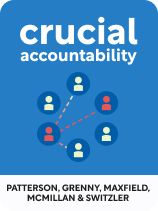

This article is an excerpt from the Shortform book guide to "Crucial Accountability" by Kerry Patterson, Joseph Grenny, et al.. Shortform has the world's best summaries and analyses of books you should be reading.
Like this article? Sign up for a free trial here .
Are you facing accountability issues at work or in a relationship? What should you avoid when talking about accountability?
The book Crucial Accountability helps readers recognize what not to do when discussing accountability issues. Many of these points can be used in other tough conversations too, not just for accountability issues.
Keep reading to tackle accountability issues in no time.
Discussing Accountability Properly
The authors stress the importance of understanding what not to do in an accountability conversation almost as much as what to do. Because we’ve likely grown up watching people handle accountability issues incorrectly, these learned behaviors slip out when we least expect them to. By understanding what not to do, we can recognize and halt these behaviors as soon as we see ourselves enacting them.
Before Giving Advice, Listen to the Other Person’s Perspective
The authors assert that we need to listen to the other person’s point of view in order to make accurate judgments and solutions when dealing with accountability issues. The issue is about the other person, therefore, they’re the ones who’ll have the most information about what went wrong and why.
Without hearing the other person’s perspective, you might be seeing the issue incorrectly or incompletely. For example, after hearing the other person’s side of the story, you might realize that their reaction was correct in that particular situation, even if they failed to meet expectations.
Don’t Bias Their Response
The authors warn that when you’re brainstorming solutions, don’t bias the other person’s response by first proposing a solution and then asking what they think. When you start off the discussion with something like “to solve this problem I think that it’s best to do X. What do you think?” you’re preventing new, and possibly better, solutions to enter the conversation.
The authors explain that this strategy stifles the production of new and better ideas in two ways:
- You’re putting ideas in the other person’s head which can stifle any new solutions they might have come up with.
- They might be hesitant to disagree with you.
Instead, the authors advise that you ask open-ended questions that don’t assume the solution.
| Don’t Use Leading Questions This practice is called asking with leading questions: Leading questions are defined as questions that lead or persuade the other person to give a certain response. These types of questions are banned from interrogations and research studies because of the effect they have on peoples’ responses. When you ask a leading question, it’s unlikely that you’ll receive the other person’s genuine, unbiased response. So, as the authors recommend, if you truly want to receive the other person’s opinions and the best possible solutions, avoid asking for their ideas with leading questions. |

———End of Preview———
Like what you just read? Read the rest of the world's best book summary and analysis of Kerry Patterson, Joseph Grenny, et al.'s "Crucial Accountability" at Shortform .
Here's what you'll find in our full Crucial Accountability summary :
- How to broach sensitive conversations with loved ones and coworkers
- How to prepare for, execute, and follow up on accountability conversations
- How to solve issues while improving your relationships






